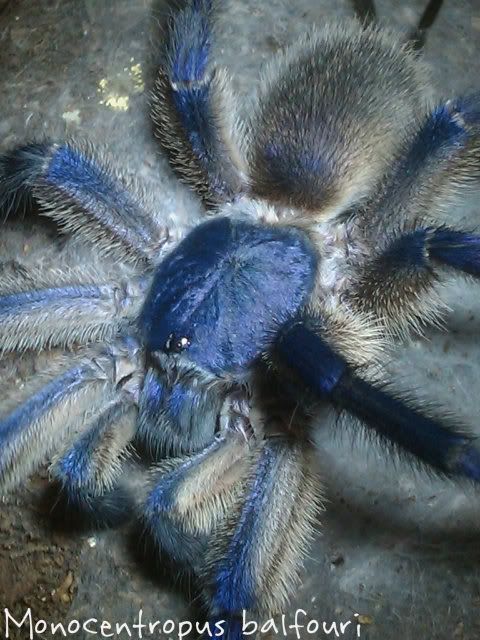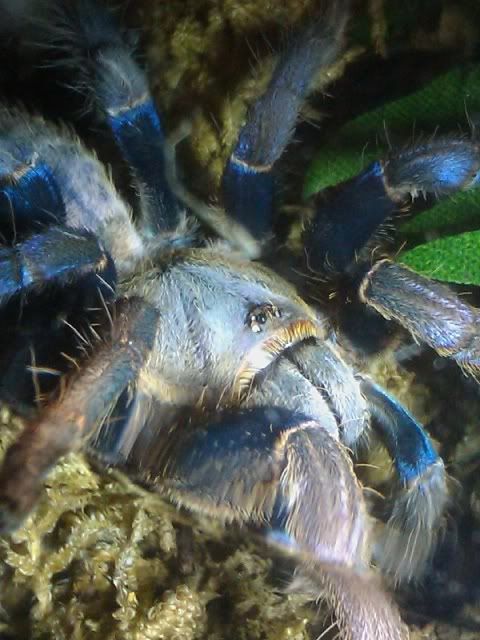spiderengineer
Arachnoangel
- Joined
- Apr 22, 2012
- Messages
- 998
Yes, a very good point.i'm sure there is a cobalt blue like that but I liken to what you are looking for as kind of buying a pure breed dog with a specific look, its all about the who parents are to the cobalt (you can't fight genetics). If there was a westminster for spiders I am sure that blue color you want would be the spider your looking for representing the haplopelma lividum breed, but I imagine that female would cost pretty penny as well.
This pic of my MM Monocentropus balfouri does not capture the true vivid blue, but it gives you the general idea... When this boy came up out of his burrow after his maturing molt, I was speechless in awe... (Hard to cause me to be speechless...) The blue was SO intense, I can't even describe it. The males get the bright blue carapace at maturation so it's a bit anticlimactic, though the blue on both M and F legs is amazing even before maturation.When I see the BRIGHT orange on my Brachypelma species I want a T that has that BRIGHT blue color on a lot of its body but (I guess) that species does not exist.


Wow! Those are awesome. So a Monocentropus balfouri has much more vivid blue colors than most of the other blue Ts?This pic of my MM Monocentropus balfouri does not capture the true vivid blue, but it gives you the general idea... When this boy came up out of his burrow after his maturing molt, I was speechless in awe... (Hard to cause me to be speechless...) The blue was SO intense, I can't even describe it. The males get the bright blue carapace at maturation so it's a bit anticlimactic, though the blue on both M and F legs is amazing even before maturation.

This is pretty close to the actual color I see when I look at this H. liv. S/he is immature, and is possibly a tad brighter IRL.

My GBBs are far more more spectacular IRL than what I can capture with a camera.
Wellll, most MM M. balfouri are vivid M. balfouri blue.So a Monocentropus balfouri has much more vivid blue colors than most of the other blue Ts?
This is true.some of the Avics have bright blue as well, just a thought.

just curios when you mean for three months is that how long you had yours. if yes then it will change eventually. I am assuming you have a deep substrate for yours to burrow and assume its not bone dry so it can make a burrow. if that is correct them enjoy it while it last. when I had wrath she didn't burrow for a long time so she would wonder around in her tank. she got the 35 gallon tank (I spoil her) after about a month of this I decided to get the burrow going for her and and she took to it didn't add on anything just mark her territory webbing everything. after that she would stay in the whole during the day but at night she continued to wander around and did this for like another 3 months or so. then at the end of july she started digging and I mean digging. she made the diameter of her burrow smaller and created a huge chamber at the bottom just among other things. once she did that she stop wandering around her tank and in fact now she just pops out and stay close to her burrow about once a week some times longer and spend most of her time in her chamber for what I can see when i look down or have her legs just at the top.For those who think they are "pet holes" View attachment 108037
Mine hangs out upside down on the vent for about an hour or so each day. I am not totally sure why she does it. She does not seem to care about motion/movement or change in airflow when she is up there.
Now, when she is on the ground it is a different story!
I keep her set-up in a trunk that is supposed to be used to store blankets in the corner of our bed room.
I will crack it open just a bit during the day to allow a minimal amount of light in and at night will keep it open and get the joys of watching her do her spiderly things.
She is fairly active at night.
With this set-up she has not borrowed at all in three months. Not saying it is right but it has worked great for me so far...
I thought most Haplopelma species hailed from southeast Asia?That baffles me. Substrate may be too wet, perhaps. Haplopelma come from a relatively dry and arid climate and burrow in dryish mud-like ground in the wild.
Yes, but humidity doesn't really do much for tarantulas. As long as they have a sufficient amount of water within their cuticle, they'll be fine. For larger juveniles and adults, this happens pretty slowly, while it takes a shorter amount of time for the young (I'm certain you already know this, just putting it out there for others to see). All of the Haplopelma I've seen in their "natural habitat" were living on dry soil. They, unlike "swamp dwelling" species (Hysterocrates, Theraphosa, for example) do not need excessive amounts of moisture to thrive, though bone dry substrate isn't good for them, either.I thought most Haplopelma species hailed from southeast Asia?
they do but there is this thing that I think people get confuse about it that high humidity does not mean wet substrate. I know pika the guy who wrote the TKG has discussed this and show picture of wild Haplopelma in dry dirt burrows which contraindicates the current mind set. however if you look at the weather channel web sight at look up any city where these ow are found the humidity is high so its necessary. the reason why the dirt there is dry and still have high humidity is because its in a tropic climate. many factors help make in have high humidity stuff I wont go in to in this post because it would be to long. one thing to consider is that they have monsoon season which is long period of rain and then it suddenly stops and then comes again about a year later. so this can be simulated in a tank and that is what essentially what people are doing. the problem is that's is really the only way to maintain high humidity in a tank is the wet the dirt and keep it wet, but that causes problems as well since you can over do it and some substrate that are soaked can bring fungus and pest you don't want . so you don't need wet dirt if you can find a way to maintain constant high humidity, but it just easier to pour water in to the substrate now and then.I thought most Haplopelma species hailed from southeast Asia?
It's my understanding that SE Asia, for the most part, stays fairly humid, even in dry season. I don't keep my H. liv like my swampers, but fairly damp during the 'wet season' that I impose on them. During their artificial 'dry season', they stay deeper in their burrows where it is more humid. While most spiders can be kept drier than their natural environments, I think those from the tropics appreciate a little more humidity. Just my observation of an extremely limited pool.Yes, but humidity doesn't really do much for tarantulas. As long as they have a sufficient amount of water within their cuticle, they'll be fine. For larger juveniles and adults, this happens pretty slowly, while it takes a shorter amount of time for the young (I'm certain you already know this, just putting it out there for others to see). All of the Haplopelma I've seen in their "natural habitat" were living on dry soil. They, unlike "swamp dwelling" species (Hysterocrates, Theraphosa, for example) do not need excessive amounts of moisture to thrive, though bone dry substrate isn't good for them, either.
http://www.youtube.com/watch?v=mRg7oxc5TCE